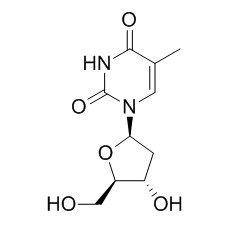Thymidine
Thymidine is a pyrimidine nucleoside that is composed of the pyrimidine base thymine attached to the sugar deoxyribose. As a constituent of DNA, thymidine pairs with adenine in the DNA double helix. Thymidine could be a tracer in tumor cell examin. Thymidine overload due to Thymidine phosphorylase deficiency, and mitochondrial toxicity caused by antiviral Thymidine analogues.
Inquire / Order:
manager@chemfaces.com
Technical Inquiries:
service@chemfaces.com
Tel:
+86-27-84237783
Fax:
+86-27-84254680
Address:
1 Building, No. 83, CheCheng Rd., Wuhan Economic and Technological Development Zone, Wuhan, Hubei 430056, PRC
Providing storage is as stated on the product vial and the vial is kept tightly sealed, the product can be stored for up to
24 months(2-8C).
Wherever possible, you should prepare and use solutions on the same day. However, if you need to make up stock solutions in advance, we recommend that you store the solution as aliquots in tightly sealed vials at -20C. Generally, these will be useable for up to two weeks. Before use, and prior to opening the vial we recommend that you allow your product to equilibrate to room temperature for at least 1 hour.
Need more advice on solubility, usage and handling? Please email to: service@chemfaces.com
The packaging of the product may have turned upside down during transportation, resulting in the natural compounds adhering to the neck or cap of the vial. take the vial out of its packaging and gently shake to let the compounds fall to the bottom of the vial. for liquid products, centrifuge at 200-500 RPM to gather the liquid at the bottom of the vial. try to avoid loss or contamination during handling.
Biol Pharm Bull.2018, 41(1):65-72
Biochem Biophys Res Commun.2018, 495(1):1271-1277
Analytical methods2019, 11(6)
Int. J. Mol. Sci.2022, 23(19), 11900.
Int J Mol Sci.2018, 19(9):E2825
Evid Based Complement Alternat Med.2018, 2018:4580627
Analytical Methods2018, 10(27)
Antioxidants.2022, 11(4), 67.
J of the Society of Cosmetic Scientists of Korea2018, 44(4):407-417
Horticulturae2024, 10(4), 382.
Related and Featured Products
J Nucl Med. 1993 May;34(5):773-9.
In vitro assessment of 2-fluoro-2-deoxy-D-glucose, L-methionine and thymidine as agents to monitor the early response of a human adenocarcinoma cell line to radiotherapy.[Pubmed:
8478710]
METHODS AND RESULTS:
The tumor cell uptake of three tracers that can be labeled with isotopes suitable for PET imaging--FDG, L-methionine and Thymidine--were examined in vitro in a human ovarian carcinoma cell line (HTB77IP3) at varying times following 30 Gy 60Co irradiation and were compared to a nonirradiated control group. FDG, methionine and Thymidine uptake per tissue culture well all increased following irradiation when compared to basal values, although to a much lower extent than the increases in uptake seen in a nonirradiated group. This increase in tracer uptake occurred despite a 6.25-fold decline in viable cell numbers. When examined per cell, FDG uptake per cell increased 9.77-fold, methionine 7.82-fold and Thymidine 9.48-fold over basal levels from Day 0 to Day 12 following irradiation. Part of these increases may be due to giant cell formation and/or radiation repair processes that require energy, protein and DNA substrates.
CONCLUSIONS:
While the in vitro system differs from in vivo systems due to the absence of a blood supply in vitro, a lack of infiltrating leukocytes and other factors, our data suggest that early assessment of human adenocarcinoma response to radiotherapy by PET with these tracers may be complicated by this normal increase in tracer uptake postirradiation. Clearly, in this human cancer cell line, early radiation-induced cell death is not associated with an early decline in tumor cell uptake of FDG, methionine or Thymidine.
Biochemistry. 2014 Oct 7;53(39):6142-50.
Thymidine kinase 2 enzyme kinetics elucidate the mechanism of thymidine-induced mitochondrial DNA depletion.[Pubmed:
25215937]
Mitochondrial Thymidine kinase 2 (TK2) is a nuclear gene-encoded protein, synthesized in the cytosol and subsequently translocated into the mitochondrial matrix, where it catalyzes the phosphorylation of Thymidine (dT) and deoxycytidine (dC). The kinetics of Thymidine phosphorylation exhibits negative cooperativity, but dC phosphorylation follows hyperbolic Michaelis-Menten kinetics. The two substrates compete with each other in that Thymidine is a competitive inhibitor of dC phosphorylation, while dC acts as a noncompetitive inhibitor of Thymidine phosphorylation. In addition, TK2 is feedback inhibited by dTTP and dCTP. Thymidine kinase 2 also phosphorylates a number of pyrimidine nucleoside analogues used in antiviral and anticancer therapy and thus plays an important role in mitochondrial toxicities caused by nucleoside analogues. Deficiency in Thymidine kinase 2 activity due to genetic alterations causes devastating mitochondrial diseases, which are characterized by mitochondrial DNA (mtDNA) depletion or multiple deletions in the affected tissues. Severe Thymidine kinase 2 deficiency is associated with early-onset fatal mitochondrial DNA depletion syndrome, while less severe deficiencies result in late-onset phenotypes.
CONCLUSIONS:
In this review, studies of the enzyme kinetic behavior of Thymidine kinase 2 enzyme variants are used to explain the mechanism of mtDNA depletion caused by Thymidine kinase 2 mutations, Thymidine overload due to Thymidine phosphorylase deficiency, and mitochondrial toxicity caused by antiviral Thymidine analogues.



